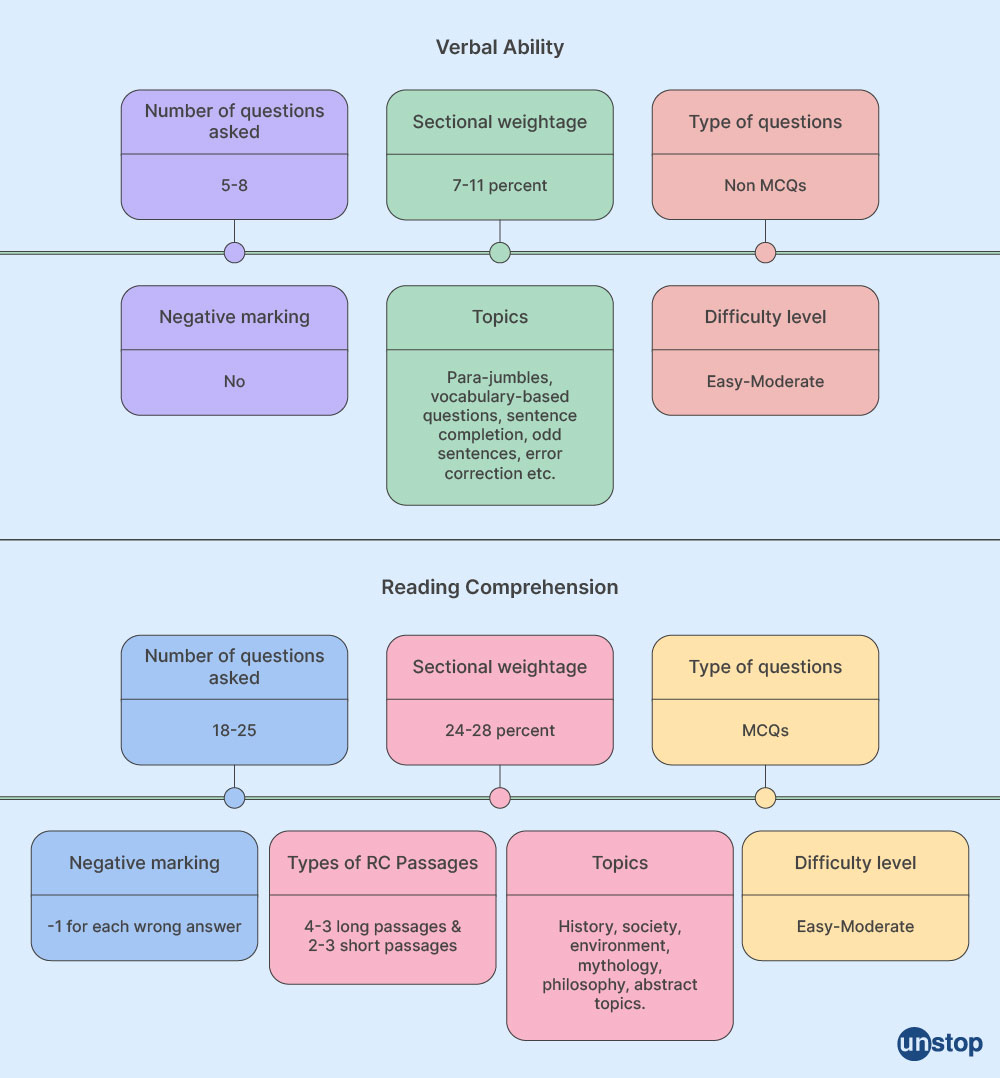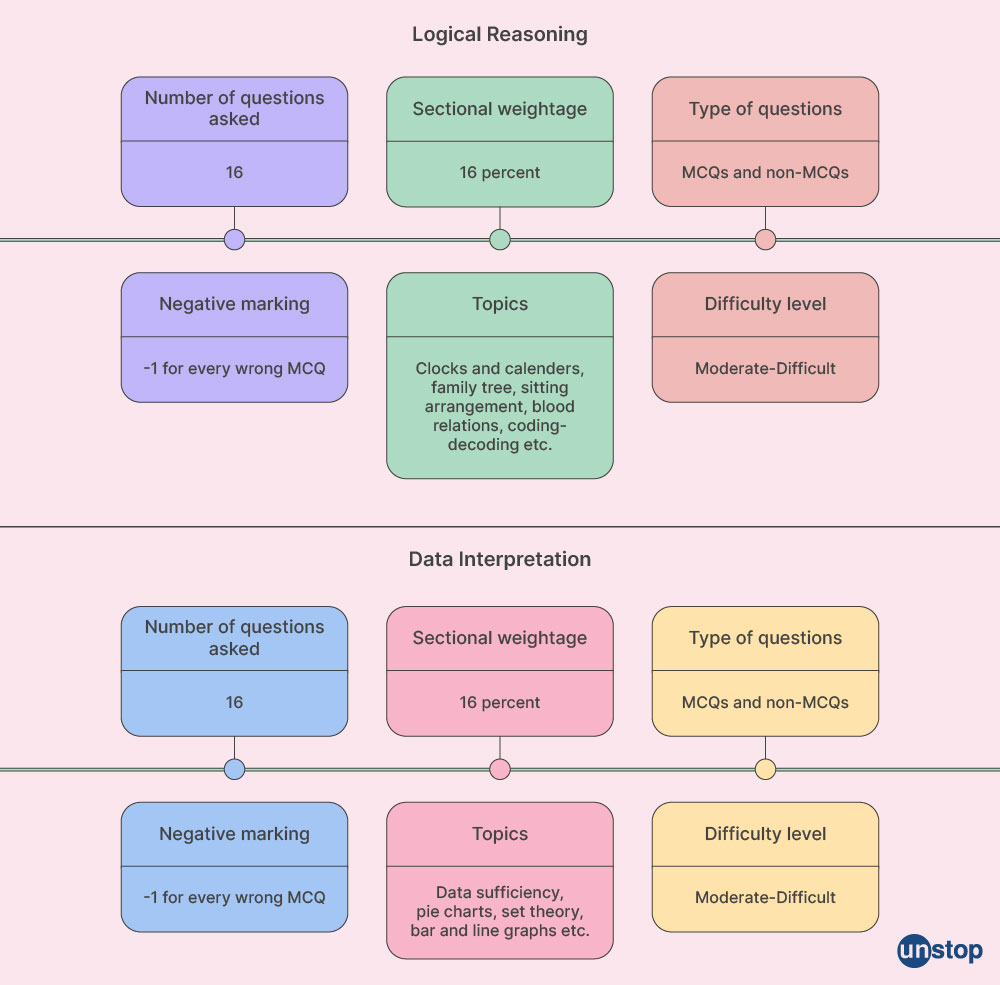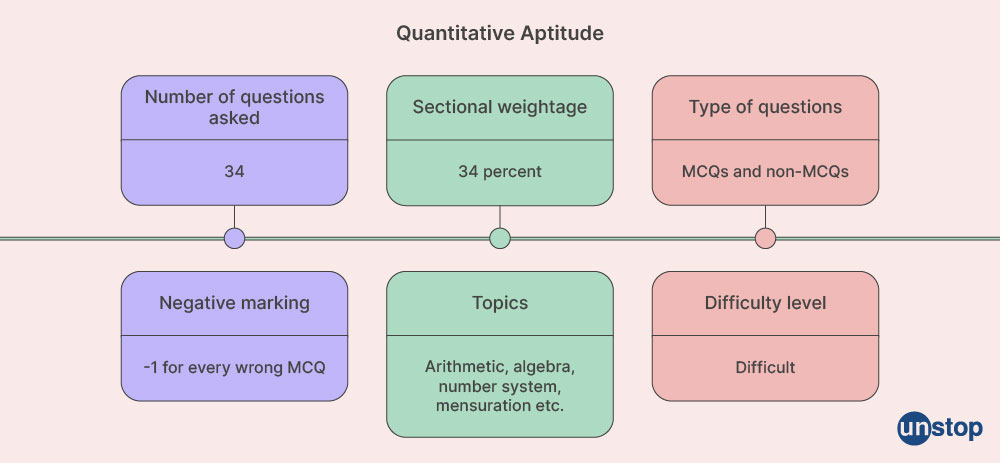- CAT Exam 2023: Major Highlights
- Latest Changes in CAT Exam Syllabus and Pattern
- Mode Of CAT Entrance Exam: Computer-Based Test
- CAT Exam Pattern: CAT Marking Scheme 2023
- Pattern for CAT Exam: Sectional Pattern Overview
- CAT Syllabus 2023: Verbal Ability and Reading Comprehension (VARC)
- CAT Syllabus 2023: Data Interpretation and Logical Reasoning (DILR)
- CAT Syllabus 2023: Quantitative Aptitude (QA)
- Books for CAT
- Prep Tips for CAT Exam 2023
- After The CAT Exam
CAT Syllabus 2023 & CAT Exam Pattern- Key Points

Every year, the Indian Institutes of Management conduct the eminent Common Admission Test, or as we more commonly know it- the CAT admission exam. This national-level management entrance exam is the gateway to admission into the 20 IIMs and 1000+ other top B-Schools in India. Every year lakhs of candidates apply for CAT, indisputably making it one of the most popular management entrance tests in the country.
Many aspirants start preparation for CAT months before the challenging exam. They wait with bated breath for any news regarding exam details, expected difficulty of CAT paper, composite score formulation, exam fee, CAT paper pattern, prep tips, etc. In this article, we bring to you all the information you will need to build a solid CAT preparation strategy and map out a preparation schedule to ensure you land a spot on the CAT merit list.
Searching jobs was never this easy! Click here to explore
CAT Exam 2023: Major Highlights
The IIMs conduct the CAT admission exam on a rotational basis. Last year IIM Bangalore conducted the exam, and this year the baton has been passed to IIM Lucknow. The scheduled date for the exam is 26th November, the registration for which began on 2nd August and will close on 13th September by 5:00 PM.
The registration exam fee is set at INR 2400, with a provision of rebate for the SC, ST, and PwD category students. The exam fee for these 3 categories is INR 1200. The minimum eligibility criteria for application is a Bachelor's degree with a 50% aggregate score (or equivalent CGPA) in any disciple from a recognized university. There is a 5% rebate in the minimum aggregate score requirement for SC/ST/PwD category students. Candidates appearing for the final year exams or awaiting results are also eligible for the upcoming CAT exam.
Latest Changes in CAT Exam Syllabus and Pattern
Since there is no prescribed official syllabus for the exam, many assume that the CAT exam pattern and syllabus are fickle and change every year. However, this is not entirely true. For example, the last change was made in 2022 by IIM Ahmedabad, which involved reducing the total number of questions in the exam from 76 to 66.
Ever since the same pattern has been followed. The duration of the exam is also the same as last year, i.e., 120 minutes (the sectional time limit is 40 minutes). For marks weightage, one can reach a broad estimate of sectional weightage through past question paper analysis.

Mode Of CAT Entrance Exam: Computer-Based Test
This year the entrance exam will be conducted across multiple test cities and centers throughout India. Each year, more than 2 lakh aspirants register for the entrance exam and are subsequently accommodated in 400+ centers in about 150 Indian cities.
Note that CAT is a computer-based test (CBT), which many confuse with the internet-based test (IBT). However, an IBT refers to a test that is conducted on an internet website and is an online test. In contrast, a computer-based test is conducted on a computer but is not an online test.
Rather than a website, the portal where the questions appear is referred to as a computer terminal. Candidates have to read and respond to MCQ and non-MCQ questions on the terminal by selecting one of the available answer options. The same terminal also has an onscreen time tracker to facilitate students in keeping a check on time spent. This helps candidates ensure that they have sufficient time to cover the questions in the respective section or adjust their time management strategy if they are running out of time.
Before shifting to the computer-based test mode, the entire exam was conducted manually in exam halls across India. It took about 30-40 days to complete the whole cycle, a process that has been simplified with the switch to computer-based tests.
Important: You are not allowed to use your own calculator in the CAT exam. However, candidates can use the virtual or on-screen calculator provided during the exam.
Don't miss out on this fun read! How would Bruce Lee answer 'Why MBA'
CAT Exam Pattern: CAT Marking Scheme 2023
As per the CAT marking scheme, a candidate will get 3 marks for each correct answer, and there is a negative marking for every incorrect answer. No marks are deducted for unattempted questions. The marking scheme for different question types is shown in the table below:
| Type Of Questions | MCQs Type | Non-MCQ Type |
|
Marks for Correct Answer |
+3 | +3 |
|
Marks for Wrong Answer |
-1 | 0 |
Ducking the negative marking to get the best CAT score possible:
1. To begin with, assess the level of difficulty of the questions in the respective section. First, attempt the easy and medium-level questions and leave the difficult ones for later.
2. Once you have filled in all the answers you are sure of, circle back to the unattended questions. If you have sufficient time to solve some of them, then go ahead. However, don't mark the answers in haste.
3. The negative marking for MCQs may deter you from attempting questions you aren't sure of, but make a sound assessment before leaving them blank. Making a judgment in this situation is dependent on
- number of correct answers
- the amount of time you are left with
- how sure you are of being able to get the answers right
4. Lastly, remember that wrong answers in the non-MCQ section don't carry a negative mark. So attempt all the questions in the non-MCQ parts of all sections.
Pattern for CAT Exam: Sectional Pattern Overview
Ever since IIM Ahmedabad tweaked the CAT pattern in 2015, the entire exam has been split into three sections. Until 2014 the CAT exam was split into two sections. These were:
- Quantitative Ability & Data Interpretation
- Verbal Ability & Logical Reasoning
But in 2015, when it was IIM Ahmedabad conducting the exam, they changed the CAT pattern completely. They remodeled the CAT pattern by switching to three sections which are followed to date.
The three sections under the current scheme for CAT admission exam are-
- Section I- Data Interpretations & Logical Reasoning (DILR)
- Section II- Verbal Ability & Reading Comprehension (VARC)
- Section III- Quantitative Ability (QA)
All these sections are individually timed with a fixed allocation to each and contain a fixed total number of questions. There are only two types of questions in the exam- the MCQ type and the non-MCQ type. In MCQ questions, there will be four answer options available for you to select from. As against the non-MCQ part questions where you will have to fill in the correct answer. This is why the non-MCQ type questions are also referred to as the TITA (Type In The Answer) questions.
Let's have a look at the detailed sectional weightage, category score, number of questions in each category, sub-category, and more.
CAT Syllabus 2023: Verbal Ability and Reading Comprehension (VARC)

This first section of the CAT question paper is divided into two sub-sections:
- Verbal Reasoning / Verbal Ability
- Comprehension passages / RC questions
The table below lists the time allotment, marks, question number, and other details about this section.
| VARC Section | |
| Time Allotment | 40 minutes |
| Time Allotment for SC/ST/PwD | 53 minutes and 20 seconds |
| Total Number Of Questions | 24 |
| Marks | 3 marks per question |
| Approx. Number of Questions - Verbal Ability | 6-8 |
| Approx. Number of Questions - RC Passages | 16-18 |
This section carries the highest weightage of all three sections, followed by QA, and will affect your percentile in the CAT exam accordingly. So when making a preparation plan for the upcoming admission exam, conduct a comparative analysis of past CAT question papers and give due importance to this section. In terms of difficulty level, the questions in the VARC sections of CAT vary from moderate to difficult.
The key topics covered in this section are as mentioned in the table below:
| Topics of CAT Syllabus - Verbal Reasoning & Comprehension Passage | |||
| Verbal Reasoning | Fill in the blanks | Para completion and inference | Verbal Logic |
|
Meaning-Usage Match |
Facts-inferences-judgments |
Summary Questions | Jumbled Paragraphs |
| Contextual Usage |
Reading Comprehension
|
Tenses | Foreign language words used in English |
| Sentence Completion | Idioms | Articles | Clauses |
| Subject Verb Agreement | Different usage of the same word | Noun/ pronoun | Conjunctions and Prepositions |
| Syllogisms | Antonyms | Phrase Modifiers | Para Jumbles |
| Analogies and reverse analogies | Sentence correction | One word submission | Other English usage and grammar |
Many students find it difficult to master the VARC section since it does not make use of formulas like the QA section. So you need to work on conceptual clarity rather than memorizing formulas. It is best to start with familiar topics and then move on to topics that you aren't as familiar with.
You need to cultivate a strong reading habit, broaden your understanding of English grammar, and work on reading comprehension if you want to ace this section and get on the CAT merit list.
Once you have enough knowledge of all possible topics in the section and have conceptual clarity on the same, take as many sectional mock tests as possible. The sample questions in these mock tests will give you an idea of the type of questions asked and how to approach the solution.
Another advantage of taking CAT mock tests early on is that the negative marking you receive for any wrong answer will help you get better at deciding the type of questions you want to skip to avoid wasting time and unnecessary deduction of marks.
Note that there will be sectional timings in CAT exam. So you will need to keep an eye on the screen clock while solving the questions. Time management requires training, and adhering to the time limits during mocks is ideal for successful preparation for CAT.
CAT Syllabus 2023: Data Interpretation and Logical Reasoning (DILR)

The DILR section, as the name suggests, is also split into two sub-section-
- Data Interpretation
- Logical Reasoning
Both the Data Interpretation and the Logical Reasoning sections of CAT have equal weightage. The details about the number of questions, duration, etc are given in the table below:
| DILR Section | |
| Time Allotment | 40 minutes |
| Time Allotment for SC/ST/PwD | 53 minutes and 20 seconds |
| Total Number Of Questions | 20 |
| Marks | 3 marks per question |
| Approx. Number of Questions - Data Interpretation | 10 |
| Approx. Number of Questions - Logical Reasoning | 10 |
The purpose of these sub-sections of CAT exam is to test the candidate's decision-making and data interpretation abilities and time management skills. Many students claim that this can be the trickiest of the three sections of CAT. However, with the right approach and right mindset, the Data Interpretation and Logical Reasoning questions can be your strength.
In terms of difficulty level, the questions in this section are moderate. And if you are quick enough to crack these questions, the chance of admission to the respective colleges of your choice will increase immensely.
The key topics of CAT syllabus that are covered under data interpretation & logical reasoning are as mentioned in the table below:
| Major Topics of CAT Syllabus - Data Interpretation and Logical Reasoning | |||
| Seating Arrangement | Reasoning Based DI | Grid-Based DI | Column Graphs |
| Tables | Data Caselets | Blood Relation | Venn Diagram |
| Syllogism | Team Formation | Clocks and Calendars |
Cube |
|
Binary Logic |
Pie Charts and Line Charts |
Logical Reasoning |
Number and Letter Series |
| Logical Matching | Logical Sequence | Logical Connectives | Other Basic Reasoning Questions |
| Data Sufficiency | Puzzles | Assumptions | Combination of two or more types linked to each other |
DILR has a vast and probably the most undefined syllabus of the three sections and hence can be a pain to prepare for. Candidates must have a strong fundamental knowledge of all the broad logical reasoning and interpretation topics mentioned in the table. The category score in this section depends equally on conceptual clarity and the candidate's ability to solve the questions swiftly as well as accurately.
Going by the syllabus for CAT exam, there is no fixed or straightforward way to master the topics in either data interpretation or logical reasoning. The best preparation plan for this section is to first conduct a comparative analysis of the past year's papers to get a strong understanding of the type of questions asked and devise techniques used to crack them.
CAT Syllabus 2023: Quantitative Aptitude (QA)

This is the last section of the CAT exam that focuses on mathematics and its applications. Many believe that engineering students perform extremely well in this particular section, while it haunts the dreams of most non-engineering students. But the bottom line is- you are being judged on the basis of performance, not your educational background. So if your preparation level for QA is good enough, and you have conceptual clarity in the topics covered in this section, you will get a good percentile in CAT exam. Before we move on to discussing the topics, weightage, etc., let's have a look at the overview in the table below:
| QA Section | |
| Time Allotment | 40 minutes |
| Total Number Of Questions | 22 |
| Marks | 3 marks per question |
The Quants section has the second highest weightage amongst the three CAT categories, hence its importance cannot be overstated. This is also one of the widest-ranging sections syllabus-wise. The table below shows the list of topics covered in this section:
| Topics of CAT Syllabus - Quantitative Aptitude | |||
| Coordinate Geometry | Quadratic and Linear Equations | Mensuration | LCM & HCF |
| Progressions and Series | Remainder Concepts | Points, Lines, and Planes | Set theory & Function |
| Arithmetic Progression | Polygons | Probability | Complex Numbers |
| Number System | Speed, Time, and Distance | Ratio, Proportion & Variation | Profit & Loss, and Discount |
| Averages | Trigonometry | Number System Shortcut for CAT | Shortcuts in Averages |
| Quantitative Aptitude Questions | Quantitative Aptitude Shortcut Techniques for CAT | Remainder Concepts | Power Cycle |
| Relatives Speed | Factorials | Circles | Geometry |
| Algebra | LCM and HCF | Percentages | Ratio and Proportion |
| Angles | Bar Graph | Permutation and Combination | Simple & Compound Interest |
| Weighted Average | Quadrilaterals | Graphical Division Geometry | Geometric Progression |
| Complex Numbers | Surds and Indices | Mixtures and Allegations | Inequalities |
| Applications of Averages | Triangles and Similar Triangles | Harmonic Progressions | Derangement |
| Laws in Set Theory | Properties of Ratio | Application of Power Cycle | Conditional probability |
| Constant Product Rule | Direction Sense | Boats and Streams for CAT | Escalator Questions for CAT |
The scope of each of these topics is vast, and you need to have a strong understanding of the basics to be able to tackle any problem that is thrown your way. There are no formal sub-sections in the QA segment, but the topics can broadly be classified into 4-5 subheads. Here is the question-wise breakup of weightage given to these subsections in the CAT questions paper.
| Topic Name | Expected No. of Questions |
| Arithmetic | 8-9 |
| Algebra | 6-7 |
| Geometry & Mensuration | 4-5 |
| Number System & Modern Maths | 1-2 |
Note that this is just an estimation based on past question paper analysis. There is no sure-shot way to tell which of these sections will get the most weightage. However, the questions in CAT exam from the past few years show that the focus on Arithmetics and algebra outweighs the focus on other sub-sections. Though a logical explanation for this trend could be that these two sub-sections cover a comparatively larger number of topics.
Irrespectively, for this section, you need to have a strong understanding of concepts, techniques, and formulas used in solving problems. It will put your calculation skills to test along with your time management skills. There will be an online calculator available on the terminal, but it is better if you sharpen your calculation skills to speed up the process rather than referring to the calculator every single time. Experimentation with Vedic maths is a great way of improving your calculation skills and increasing your speed.
The best way to prepare and subsequently assess your preparation level in QA is to solve a ton of sample questions and sectional mock tests. Many students believe that if they prepare thoroughly for this section, it boosts their performance in the DILR section as well. So pull up your socks and get cracking at the CAT exam sample papers now!
Books for CAT
There is a wide range of books for CAT available in the market. If you are preparing for the upcoming exam, here are some books that will come in handy for you:
- How to Prepare for Quantitative Aptitude for the CAT - by Arun Sharma
- How to Prepare for Verbal Ability and Reading Comprehension for the CAT - by Arun Sharma and Meenakshi Upadhyay
- How to Prepare for Data Interpretation for the CAT - by Arun Sharma
- Quantitative Aptitude for Competitive Examinations - by R.S. Aggarwal
- Verbal Ability and Reading Comprehension for the CAT - by Nishit Sinha
- Word Power Made Easy - by Norman Lewis
- Logical Reasoning and Data Interpretation for the CAT - by Nishit K. Sinha
- The Pearson Guide to Verbal Ability and Logical Reasoning for the CAT - by Nishit K. Sinha
- CAT 10 Year-wise Solved Papers - by Arihant Experts
- How to Prepare for Logical Reasoning for the CAT - by Arun Sharma
Remember that the CAT exam pattern and recommended resources can change over time, so it's a good idea to double-check the latest editions and reviews before making your study plan.
Also Read: How to prepare for CAT in four months!
Prep Tips for CAT Exam 2023
Here are some important prep tips:
- Before structuring a CAT preparation strategy, go through the syllabus topics and make a note of important points. Then conduct a section-wise analysis of the topics of the CAT syllabus and jot down your sectional strengths as well as weakness.
- Once you have earmarked your strengths and weaknesses, start practicing the major topics while analyzing the PYQs. Also, start studying your weak topics from the basics to build a strong foundation.
- While you prepare for the exam, don't lose your grip on current affairs. For this, reading the newspaper regularly is the best option. It not only helps you prepare for the PI round but also builds your vocabulary.
- Mock exams are the holy grail for anyone who wishes to bag a spot in a top-tier B-School. So solve maximum questions and take as many sectional as well as full-length CAT mock tests as you can.
Note: Candidates are given three options to choose from once they have filled in their answers. These are: save & next, clear response, mark for review & next. The last option acts as a fail-safe in case you are not sure of your answer yet and want to move on to the next question. You can come back to review such questions later on. Remember that once a section is done, you cannot go back to it later.
After The CAT Exam
Once the CAT exam is completed, the results will be declared somewhere in January of next year. IIM Lucknow, which is conducting the exam this year, will release the CAT exam results.
Once the results are declared, all the IIMs will release a campus-wise minimum requirement cutoff marks list. They will then prepare a merit list for students who are eligible for admission. This merit list is prepared on the basis of a composite score which takes into account a candidate's CAT score, past academic record, graduation percentage, diversity, etc.
All institutions have different methods of calculating the composite score. IIM Ahmedabad, for example, gives a 30% weightage to previous academic performance (PAP) in the composite score, while IIM Bangalore gives a weightage of 50% to PAP. Students who qualify as per this score are called for an interview, and the admission process moves forward.
With all this information in your kitty, we are sure you will frame a winning CAT preparation strategy and ace the exam in November. #BeUnstoppable
You might also be interested in reading the following:
- 90+ MBA Interview Questions For Commerce Graduates Asked By Top B-Schools
- This 22 Year Old IIT Bombay Lad Scores 99.99 Percentile in CAT 2021 in First Attempt
- 8 Best Books For CAT Preparation: Know How You Can Ace CAT 2022
- NITIE Mumbai To Convert To IIM Mumbai?
- Is MBA Entrance Easier For Engineers? Here’s What IIM Ahmedabad 2022 Admission Data Says
An economics graduate with a passion for storytelling, I thrive on crafting content that blends creativity with technical insight. At Unstop, I create in-depth, SEO-driven content that simplifies complex tech topics and covers a wide array of subjects, all designed to inform, engage, and inspire our readers. My goal is to empower others to truly #BeUnstoppable through content that resonates. When I’m not writing, you’ll find me immersed in art, food, or lost in a good book—constantly drawing inspiration from the world around me.
Login to continue reading
And access exclusive content, personalized recommendations, and career-boosting opportunities.
Subscribe
to our newsletter
















Comments
Add comment